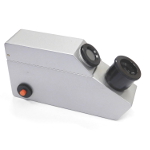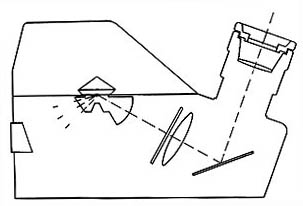The refractometer |
Français Deutsch Artists Collection Education Mineralshows Publications Tools Contact Links Back to Home | ||||||||||||
is used to measure the refractif index of a gemstone. The stone needs a flat and polished facet. Together with a contact liquid the stone is placed on the refractometer.
You read the refractif index on the scale visible trough the ocular. The examination is carried out on 4 or 8 different positions, through rotation of the stone. At the same time you rotate the polarising filter on top of the ocular. When encountering an anisotropic stone, this will produce a movement of the separation line between dark and bright. Note the lowest and highest value. The correct interpretation of this results, reveals if the stone is isotrop or anisotrop. The anisotrop stones can be separated in two groups: uniaxe and biaxe. In most cases you can determine their optical character as either positiv or negativ, in addition you determine the maximal double refraction (BR).
Each mineral has a typical refractif index due to its chemical composition and due to its cristallisation structure. The refractometer allows to observe the optical properties and the structure of a gemstone. These properties are usually invisible to the naked eye. It allows to determine a great number of precious stones with precision.
Take care of your refractometer and this tool will serve you for a life time. Anderson Liquid 1) The contact liquid usually delivered with a refractometer is diodmethane with a refractive index (RI) of 1.79. A solution of "iodure de méthylène + du soufre". 2) A contact liquid with an RI of 1.81 exists. It is a solution of "iodure de méthylène + du soufre + tétraïodéthylène". This liquid is very corrosive and its toxicity is the reason why trading is forbidden in France. 3) The liquid with RI 1.74 is composed of "iodure de méthylène" and not of great interest in gemology. Because to many stones can't be analyzed anymore. Attention protect the liquid from temperature changes and protect from temperatures over 24°C. The sulfur starts to crystallize and the RI will drop. Close the bottle tight after use. Don't inhale or touch with your fingers, as all 3 liquids are toxic.
More information and pricelist here
| |||||||||||||


